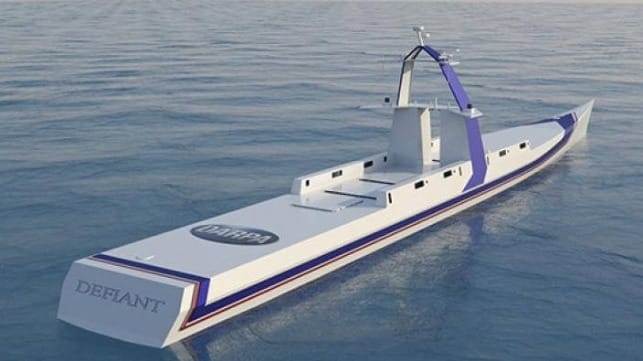DARPA Christens U.S. Navy’s First Fully-Unmanned Oceangoing Ship
DARPA Unveils Revolutionary Unmanned Warship NOMARS

The Defense Advanced Research Projects Agency (DARPA) has officially launched its groundbreaking unmanned warship prototype, the No Manning Required Ship (NOMARS). This innovative vessel represents a significant advancement in the U.S. military’s efforts to develop unmanned maritime technology, following the earlier ACTUV/Sea Hunter system introduced in 2016. NOMARS is designed to operate autonomously for extended periods, showcasing a new era in naval operations.
Design and Capabilities of NOMARS
NOMARS is engineered to navigate the limitations of the U.S. shipbuilding industrial base. Its streamlined hull design prioritizes speed while ensuring that it can be constructed at Tier III shipyards, which are more accessible than the heavily burdened Tier I contractors. With a length of 180 feet and a displacement of 240 tonnes, the design allows for a wide range of shipyards, including those specializing in workboats and yachts, to participate in its production. This approach aims to expedite the construction process and reduce wait times.
The vessel is equipped with an open deck that can accommodate various containerized payloads, including up to 16 Mk 41 vertical launch system missile cells. However, its primary mission is to demonstrate the feasibility of fully unmanned, long-distance operations. By eliminating the need for crew members, NOMARS is designed to be lighter, more cost-effective, and more expendable than traditional manned vessels. DARPA aims for the ship to operate for up to 12 months without human intervention, addressing one of the major challenges in developing reliable unmanned systems.
Used Vehicle Lashing Belts on Oceangoing Ships to Be Recycled into Solid Fuel
During the unveiling ceremony, NOMARS Program Manager Greg Avicola emphasized the vessel’s resilience, stating, “Defiant is a tough little ship and defies the idea that we cannot make a ship that can operate in the challenging environment of the open ocean without people to operate her.” He highlighted that NOMARS is built for extended voyages and can endure operations in rough seas, ensuring continued functionality even after storms pass.
Future of Unmanned Naval Operations
Following initial at-sea demonstrations, the Navy’s unmanned research and development office, PMS 406, will take possession of the Defiant, marking a significant milestone as the service’s first fully unmanned oceangoing vessel. This transition underscores the Navy’s commitment to advancing unmanned technologies and enhancing operational capabilities.
As DARPA prepares for further testing, the NOMARS project is poised to redefine naval warfare and maritime operations. The agency’s focus on mechanical reliability and endurance could pave the way for a new generation of unmanned vessels, transforming how the U.S. Navy approaches maritime missions. With ongoing developments, the future of unmanned naval technology looks promising, and the world will be watching closely as NOMARS embarks on its journey.
